(Continued from Part 1.)
The first step in processing harvested seeds is to remove them from whatever the plant has stored them in. Many seeds are encased in small dry seed pods, or fine seed heads, either of which can be rubbed between your hands to separate the seeds out. This creates a lot of dust and detritus which must be removed by using some of the equipment mentioned above or other various methods. Larger dry pods, like beans and peas, can often be opened and the seeds easily stripped out while the pods are tossed aside.
Seeds from many fleshy-fruited plants such as cucumbers, tomatoes, and squash can be removed with some of the pulp, soaked in water for 48 hours, then more easily separated out. Using this fermentation method can kill many of the pathogens tomatoes are prone to, but not all.
A large portion of the seeds I collect require screens for separating the chaff from the seeds. When using screens, sometimes the seed falls through, sometimes the chaff falls through leaving the seeds on top, and sometimes a little of both. It depends on what kind of seed you are working with and the more experience you get, the better idea you’ll have of which methods and screens to use for each seed type.
Some Seed Cleaning Examples
Following are some examples of each seed-cleaning method I use.
The first example uses buckwheat. Buckwheat has a fairly large angular seed, slightly smaller than a pea. They are easily harvested by grabbing handfuls of dry material from the tops of the plants and putting them into the harvest bucket. When I have enough to process, I reach into the bucket and roll everything between my hands until the seeds are more or less separated from the stems. Photo 6 shows what they look like after I finish this process. You’ll notice there are large pieces of chaff, seeds, and lots of finer particles of dust and detritus.
PHOTO 6 – Buckwheat After Collecting
Photo 7 demonstrates what happens as the buckwheat passes through two different screens. Using the ⅛” mesh first (A) all the dust and small detritus is removed. The seeds and larger chaff remain on top of the ⅛” screen (B), then most of the chaff is left behind when the seeds are sifted through the ¼” mesh (C). The majority of the chaff is removed leaving 98% clean seed.
PHOTO 7 – Buckwheat Processing
Photo 8 shows some of the stages of amaranthus collecting and processing. The amaranthus I grow is a seed grain smaller than quinoa, but there are many ornamental varieties as well. It has two special problems. First, the seeds fall out of the heads very easily, and second, they don’t all ripen at once. Normally with this and lambsquarter (quinoa’s sibling) I go out to the garden and shake the heads into a bucket to harvest that day’s mature seeds, then return a few days later to repeat the process. This particular amaranthus (A) was a volunteer plant that needed to be harvested all at once so the burn pile could be lit.
To keep the seeds from falling out, the heads were carefully held upright and then tilted over into the bucket (B). Since most of the seeds were not yet adequately dry and therefore stuck in the seed heads, the broken-apart heads were left in the bucket to dry for a week (C), receiving daily rubbings to remove any seeds which were dry enough. Once the branches of the seed head were completely dry, they were rubbed together one last time and everything dumped into a tray. By swishing the tray back and forth while tilted, the chaff rises to the top and the heavier seeds settle to the bottom of the tray (D). This “swishing” is similar to panning for gold and works well with many seeds.
If you’re okay with getting only 80-90% of the seeds, screens are unnecessary and the seeds and chaff can be swished so the seeds settle to the bottom, then the majority of the chaff can be removed with your fingertips. You’ll still end up with a little dust and chaff mixed in but that’s okay. In the amaranthus below (D), the seeds which have swished out will go directly to the finest screen while the rest of the chaff is rubbed again, then screened for the remaining seeds.
PHOTO 8 – Amaranthus
Many of the best herbs are in the mint family: basil, oregano, and catnip being but a few. These have very small seeds which can be difficult to separate from the chaff, but is made easier by employing a few tricks. The seeds are so small I use only the window screen. In Photo 9 catnip seeds are being processed. The larger pieces of chaff are left behind (A) but most of the dust and detritus falls through with the seeds (B). By blowing very lightly on the pile (C), most of the lightweight detritus can be blown away leaving mostly seeds behind. Based on your tolerance for chaff mixed with the seeds, the resulting pile in (D) may be good enough.
PHOTO 9 – Catnip
If you want your seed cleaner yet, put it into a bowl and use the swishing method to get more of the chaff to rise to the top where you can then blow it away to create the cleaner seed seen in Photo 10.
PHOTO 10 – Cleaner Catnip Seed
Oregano is similar to catnip but the seeds are only slightly heavier than the dust and detritus, making it more difficult to blow away. Photo 11 shows the seed stalks as they are harvested (A) and after they have been rubbed together to remove the seeds, then passed through the finest screen (B). In C you’ll notice that while much of the seed and detritus have been separated by blowing, much of the seed has remained behind.
Since most of the mint family tends to make a bazillion seeds, it’s generally not important to get every last seed. Photo 11D shows the very tiny seeds being picked up with an index card to place in the storage envelopes. As a side note, I save all the seed-cleaning remains in a single bucket, then scatter them along a nearby power line right-of-way and roadsides in front of my homestead where the plants are mostly weeds like ragweed. The seeds remaining with the chaff have a second shot at germinating and making their contribution to the world, or just feeding birds.
PHOTO 11 – Oregano
Many seeds are as small, or smaller, than the mints but have very smooth coats in comparison. Celosia, lambsquarters, and quinoa are among this group. Since the seeds are so tiny they go straight to the smallest screen and this time we’ll use the coffee can (Photos 12A & B). In C the seeds and chaff have been dumped into the coffee can where the chaff remains on top of the screen while the small seeds fall easily through. With a little bit of blowing, the remaining chaff is removed (D), forming the small pile of dust and debris shown in the red circle.
PHOTO 12 – Celosia
Photo 13 is showing celosia again, not the best example, but many seeds benefit from the more constant air flow of a small computer fan as opposed to puffing your cheeks and blowing on them. By moving the fan closer or farther away, you can regulate the speed and quantity of the air movement to get just the right amount for those trickier seeds which are only slightly heavier than the chaff.
For larger, heavier seeds with relatively lightweight chaff, a large box fan can be set up in front of the box lid shown in Photo 2C and the seed/chaff mixture dropped in front of the stream of air. The heavy seeds will fall into the box lid while the chaff is blown farther away. This works well for things like dry beans and grains which are often the same size as the chaff making screening ineffective, but the difference in weight between the two is so great the box fan works very well.
PHOTO 13 – Fan Method
(To be concluded tomorrow, in Part 3.)

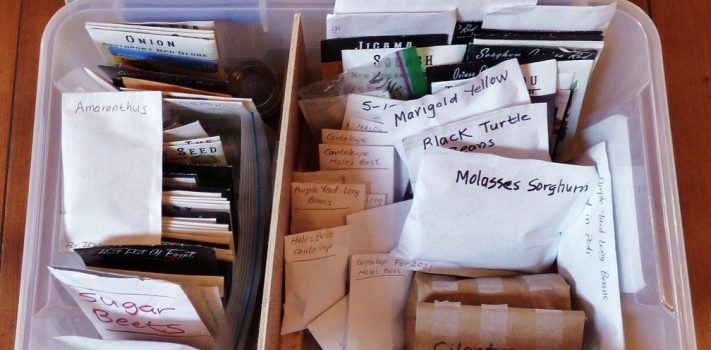












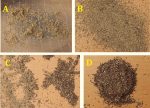
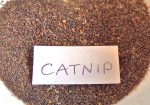
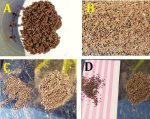
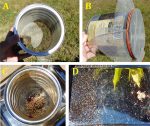
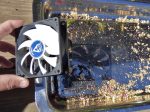
There’s a lot to this; it’s amazing any of my saved seeds sprout! Learning lots of good stuff!
Hey Animal House, there are only two main requisites for saving seed successfully. The most important is that they are completely dry before storing, the other is that they should be in pest-proof containers. Everything else is just a nicety. If you take a cob of corn and toss it in a paper lunch sack, that works. If you remove the seeds and pulp from a squash and just dry them out without further cleaning, then roll them up in newspaper, that works too.
When our seed collection gets so large we have to store it in 55-gallon drums, then all the cleaning and chaff removal is nice so we can package them in neat envelopes to better organize them in our smaller, pest-proof containers. And when you open your seed store post-TEOTWAWKI, it gets pretty embarrassing when you are retrieving seeds from the 55-gallon drum and fall in with just your wiggling feet sticking out of the top. Customers find it entertaining but for your own sake, nicely labelled packets look more professional and you can get 50 rounds of .22 instead of just 25. Until then, whatever you do works as long as they are dry before storing in a pest-proof container. The important thing is to store seeds, which is sounds like you’re already doing. 🙂
Animal House, When we save seeds we are considerably more picky than Mother Nature. She puts out a bazillion seeds and only expects a small percentage to actually survive. It’s kinda the same thing with everything that produces a lot of ‘young’. Why do chickens
rabbits and sardines produce so many young ‘because everything wants to eat them’! Seeds are the extreme example of this, from living soil to human beings EVERYTHING eats seeds.
SEEDS
“For thousands of years storing seeds has been an essential part of the survival preparations made by millions of prudent people fearing attack. Seeds are hopes for future food and the defeat of famine, that lethal follower of disastrous wars.”
Among the most impressive sounds I ever heard were faint, distant rattles of small stones, heard on a quiet, black, freezing night in 1944. An air raid was expected before dawn. I was standing on one of the bare hills outside Kunming, China, trying to pinpoint the sources of lights that Japanese agents had used just before previous air raids to guide attacking bombers to blacked-out Kunming. Puzzled by sounds of cautious digging starting at about 2:00AM, I asked my interpreter if he knew what was going on. He told me that farmers walked most of the night to make sure that no one was following them, and were burying sealed jars of seeds in secret places, far enough from homes so that probably no one would hear them digging.
My interpreter did not need to tell me that if the advancing Japanese troops succeeded in taking Kunming they would ruthlessly strip the surrounding countryside of all food they could find. Then those prudent farmers would have seeds and hope in a starving land.”
Nuclear War Survival Skills – by Cresson Kearny
http://www.oism.org/nwss/s73p920.htm
CH. 9, pgs 92-93
Hey Anonymous,
Thanks for the interesting story and the link.
The entire book looks interesting and useful, “Nuclear War Survival Skills” and most of the info is not necessarily nuclear based, just good survival skills which preppers need.
I just downloaded a copy, here’s the link:
http://oism.org/nwss/nwss.pdf
Seems like it would be a good item for the SB Stick if it isn’t already there.
I have found at the local level that Master Gardeners are a huge resource for seed preservation for edible gardens.
https://en.wikipedia.org/wiki/Master_gardener_program
You might want to check with your local extension office. There may be local associations in your area.
In my area, you probably don’t want to discuss politics with them, just stick to seeds and gardening…
I can’t remember who, but someone on the Internet recommended this item for seed storage and organization:
IRIS USA, Inc. KP-XLPHO 4″ x 6″ Photo and Craft Keeper, Extra Large, Clear
https://www.amazon.com/gp/product/B004T6I6RA/
What do others think about this?
Hey Anonymous, as near as I can tell from the photos, it looks like that box doesn’t have a gasketed lid which, speaking from experience, is necessary to keep out weevils and meal moths among other things.
There are many options but here’s what I use, $16 at Walmart though I actually got mine at Home Depot:
https://www.walmart.com/ip/Ziploc-16-Quart-4-Gallon-WeatherShield-Storage-Box-Clear/38345581
Notice the blue gasket that goes all around the entire lid. Many of these types of storage boxes only have the two end locks, these with the gasket have four of the blue locks.
Amazon has better pricing but it looks like they only come in 4-packs. The 16 quart is 18 x 12 x 7″ but any other size would work just as well. I use these because they stack two high in the cupboard where I keep them.
Other people probably have some ideas which would also work. In Part 3 tomorrow I go into a little more detail on this.
I use that one and very happy with it! It’s not cheap, but very functional. As the author says (more or less), you have to store in a place without the potential for infestation. It’s very efficient for organizing your various seeds….!
Hey, St. Funogas, great article!
Nice article on seed saving. Garden seeds have the potential to become a type of “currency” all by themselves. They will no doubt be bartered for other items of use by some sheeple waking up at the last minute. Additionally, garden produce will also become a trade item.
St. Funogas, Thanks for this article, lots of good information.
2 questions sir, if you will. 1. I have a tomato plant that grew from last years plants. The tomato’s were green until we had a frost. Can the seeds be saved? 2. I cut open a tomato from a different plant this morning, it was full of sprouts. Any suggestions on keeping the sprouts alive?
Hey SH, the seeds from the green tomatoes are almost certainly non-viable. You can roll some up in damp paper towels, not too wet, then put that in a plastic bag and see if they germinate. If they do, then save the rest.
On your sprouted seeds, it’s probably best to save some of the non-sprouted ones if there are any. As far as the sprouted ones go, if you have the room on a south-facing window you can do a fun experiment. If you grow the plants now they will be very tall and spindly by spring. You could let them get tall and spindly and then take cuttings to restart them whenever they need it, then have some plants to take cuttings from in the spring to plant in the garden. Tomatoes grow very easily from 3″-4″ cuttings and are easy to root in water. The main thing to remember when taking cuttings is to do it just below leaves are coming out, less than ¼” below. Then break the bottom leaf off and put the stem in water until the roots form. The only thing you have to watch out for are mites. Scientists say there’s no such thing as spontaneous generation but they’ve obviously never battled mites on tomatoes. They come from out of nowhere.
Thank you Sir for the reply. The sprouted tomato was put in a South facing window yesterday. Today it looks like a chia pet, so we plan to play with this one. Hopefully, It’s not from the Little Shop of Horrors, we will see.
The Green Tomatoes turned brown last night. They will go into the compost.
Old seeds will sprout and grow. I took a Botany course in college, where one of the lab projects was to sprout old seeds.
……. The college had old seeds stored in 5 gallon glass containers in a dark closet. The instructor gave every student 10 bean seeds for each year. This Botany ‘course’ has been taught since the Wagon Trains rolled West.
……. The oldest seeds in my time period were about 50 or 30 years old. The teacher ‘jumped’ the years in 5 year increments. Everyone had to sprout the seeds in paper towels. The seeds were locked in a student desk drawer.
It was a learning process. The oldest seeds (from long-ago) had been used up over the years. Still, we had relatively old seeds and new seeds. … Yes, the seeds ~sprouted. The newer seeds had a better success rate.
…….. Over the years of teaching, the college knew the expected success rate for expected sprouting. The kids were told how to take care of the seeds, to obtain good sprouting results.
…….. Screwballs or people born with a deadly thumb didn’t pass that section of the course. [A deadly thumb is opposed to a ‘green’ thumb. Some people are just more attentive to plants, and can get the results.]
Everything in St. Funogas great article can be taught in College Course.
*************
*************
+Anyone, that’s had a garden or lawn to take care of; knows ~unwanted seeds can lie dormant for years, and then sprout (when you want them to still sleep in the soil).
In the desert country, seeds lie in the soil for years waiting for rain. The seeds sprout and grow spectacularly with sufficient rain. Of course, God is the Master Gardner.
Hybrid seeds have their problems with harvesting the seeds, and using the seeds to grow crops. …. Farmers buy ~new hybrid seeds to help ensure growing and producing success. … Real money is on the line in farming; the bills, taxes, and the bank need to be paid.
[Money farmers don’t want to waste their time planting any old bag of seeds. Farmers buy new seeds. … Farmer seeds are treated with chemicals. Commercial farmers are farming ~money results.]
Harvested hybrid plant seeds to use next year can give screwball growth;+ it can be a big waste of time. … Old granny ladies keep ~’store bought packages’ of seeds partially used or unopened. … The seeds will still work. The crop or flowering plants might NOT be as fruitful. … But, it’s a waste to throw away, any store bought seed package with seeds still in it. [Hybrid or not]
***
***
Harvesting your own seeds to preserve requires information. = Stick with, SurvivalBlog and St. Funogas.